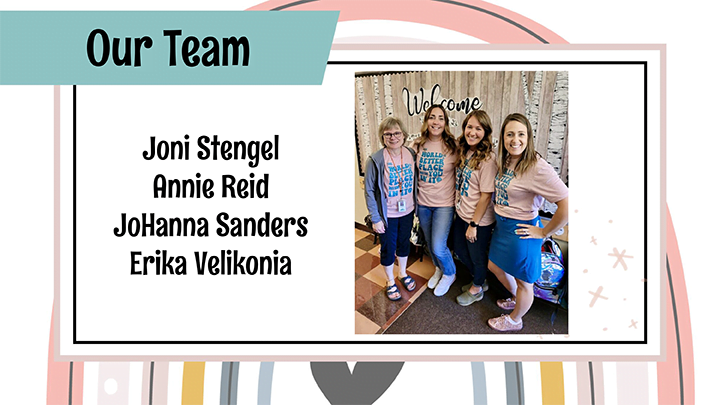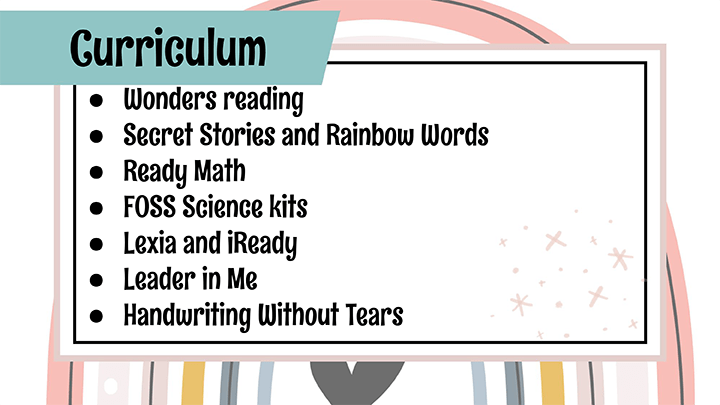Elementary / Classes / First Grade
Welcome back to First Grade!
Nuts and Bolts
Attendance:
Attendance is critical to student success. This is very important to SES and to me as your student’s teacher. Please plan for school to be the priority. Of course, we understand inevitable absences or tardies. Please try your absolute best to help your student be present at school and get there on time. If your student is going to be absent longer than 5 consecutive days, you will need to reach out to the front office for an extended absence form. Students who are just out sick for a day or two will not need homework or classwork sent home. Just focus on feeling better, reading and I will get them caught up when they return.
Snack:
Please send a snack with your student each day. This should be a small snack that they can finish within 5-10 minutes. Encourage your first grader to help you pack their own snack for the day! Donations for extra classroom snacks are always welcome! However, students catch on VERY quickly to the fact that usually have a small stash of extra snacks. Please share with your student that these extra snacks are for when a student really honestly forgets or wasn’t able to bring a snack for the day. We will have snack towards the end of our day when students need a pick me up.
Reading at Home:
Reading is a huge piece of first grade! Reading may still look different for every first grader, but reading at home is so important. We are a no homework school, however we do encourage 15 minutes of reading every night. Please help your child find a love for reading by encouraging this with us!
Water Bottles:
Please send your student with a water bottle every day. It really helps maximize our learning time when students have water at their seats. I will remind them to bring bottles home on Fridays.
Toys and Fidgets:
I have lots of amazing tools and toys for students to grow their brains in my classroom! Please help me by reminding your student to leave toys and “pop-it’s” at home. This includes Pokémon cards as well.
Thank you!
Behavior
Philosophy:
My philosophy on behavior is that I want to teach students a combination of soft skills (interpersonal skills) and positive character traits that. They will carry with them as they leave first graces. I teach social emotional learning in my classroom. I teach lessons based on student need, but also create an atmosphere where social emotional learning is part of every minute of our day. Students will dive into problem solving skills, communication with peers, self-esteem, ways to manage emotions, responsibility, respect, making mistakes, etc. There are so many valuable soft skills and character traits that definitely impact student behavior. By creating a classroom atmosphere centered around social emotional learning, I see a positive effect on student behavior. We will use two curriculums to help use achieve some social emotional goals. We will use GEM (growing early mindsets) and LIM (Leader in Me). I will send newsletters home specific to these curriculums so that families can reinforce these skills at home.
Management:
I am here to help guide students, with grace, to making great choices inside and outside the classroom. I hold a loving but firm boundary with students and their behavior. I bring an understanding that students in first grade are still learning and producing MANY social skills. I start us off strong with a lot of positive reinforcement as we learn first grade and classroom specific expectations. I introduce expectations through various hands-on activities. As we dive into more of our social emotional learning, students will recognize that they grow neurons when they make mistakes, make responsible choices, use teamwork, etc. My goal is to always celebrate growth.
Students who have a hard time being respectful of our class will have support from me in various ways. Goal setting is a great way to help students see success. This may look like a sticker chart, tracking sheet that goes home, positive reinforcement notes home, or just a simple goal they create that lives on their desk as a reminder. Goal setting is a real world skill that often helps students move forward in a positive way. Physical
behavior such as hitting or kicking another student is not welcome. Students who have a difficult time with this will fill out a “think sheet” (a reflection of behavior or incident) with me, provide some kind of apology conversation with the other student, brainstorm a consequence if applicable, and Bring. e think sheet home to reflect with their family. This is a great way for students to have a problem solving conversation about their unexpected behavior with me and you. Unwelcome behavior that continues can be discussed in a goal setting meeting between parents and teacher. I want to be your teammate in helping your child succeed! I have no doubts that students are going to do their best to make great choices!
What are Secret Stories?
I LOVE Secret Stories! Let me just shout that again!
I LOVE Secret Stories!
How many times do we find ourselves as adults saying “that’s just the sound it makes.” Secret Stories has allowed me to deepen my understanding of why certain letter combinations make certain sounds. I am still learning more and more as a teacher. Adults never stop learning! Secret Stories is a brain based approach that provides kids with logical explanations for letter/sound behavior. Students will learn the “secrets to reading” as we work our way through learning each secret story. The learning cards that show the secrets combine fun illustrations and cartoon with a story that is hard for the kids to forget.
Here is an example:

What are Rainbow Words?
First graders will use their rainbow words a lot! Rainbow words are another way of saying “sight words”. These are common words seen over and over again in books that can be tricky for young readers to isolate sounds and sound out. Here are some examples of sight words:
and the they is who out said
Students will start at the “red” level and work their way through each colored level to create an entire rainbow if possible! The colored levels correspond with first grade reading levels that progressively get harder throughout the year. By the end of first grade, we would ideally like students to be able to read through the blue level. We will send a list home.
A common misconception with sight words is that readers should memorize them. There has been much research on this, and studies have found that teaching readers to sound out tricky words actually sparks more brain power: and critical thinking skills. We want students to learn to use their Secret Stories to help them with their rainbow words. For example: “Do you see a secret in the word OUT?” Students should identify the “OU” secret and sound: to help them with this sight word.
We encourage families to have fun practicing rainbow words at home! There are so many out of the box ideas when it comes to practicing sight words.
Here are a few ideas:
Sidewalk chalk paint draw in sand playdough
Scavenger hunt tic tac toe flashcards plastic egg hunt
Alphabet stamps find and swat Legos
View and Download the First Grade Overview
The Basics
First grade marks an important milestone for young children who finally feel like part of a “big” school. They may eat in the cafeteria for the first time or play outside during recess without the direct supervision of their own teacher, experiences that help first graders feel more independent. First graders now have to use the social skills they developed in preschool and kindergarten in more mature ways. But the true magic of first grade happens as children develop the ability to understand what letters and numbers really mean. When they’re ready, they’ll be able to “crack the code” and read words.
Language & Literacy
First grade is traditionally thought of as the level where children learn to read. Not all children become fluent readers by the end of the first grade, but most take their first solid steps toward fluid reading. Their reading material varies from simple rhymes, to classroom news, to patterned stories and beginner non-fiction books. By the end of the year, most are reading grade-level chapter books and some are reading at even more advanced levels. First graders love true stories of long ago, even though their sense of time isn’t well developed. Some good historical books include “The Man Who Walked Between Two Towers” by Mordicai Gerstein, “My Brother Martin” by Christine King, and “The Story of Ruby Bridges” by Robert Coles.
First-grade teachers help children listen for sounds in words, write the sounds they hear, and discover parts of written language, like the –at in cat that they can then use to figure out the words hat, mat, and sat.
Writing, like reading, takes a variety of forms in the first-grade classroom. Children “invent” their spellings as they work out their understandings of written language. Writing activities include journal writing, writing creative stories, or documenting their work in other subject areas. Teachers frequently ask children to sound out the words they write to introduce the sounds that letters make.
Math
First graders begin to grasp more abstract mathematical concepts. Children are introduced to time, money, and the meaning of numbers greater than those they can count. Because first graders still learn best by working with physical objects, teachers give children materials to use during math lessons such as number cubes, pattern blocks, and color rods.
First graders start to do simple addition and subtraction problems. They learn to count by 2s, 5s, and 10s, which will help them later when doing math equations. They also work with 2- and 3-dimensional geometric shapes.
Ciencia
Teachers encourage first graders to find their own answers to questions about the natural world, and to learn to find patterns in that world. They may be introduced to concepts that require them to understand more than they can explore concretely, such as living things being made up of small parts. Common science explorations include water and weather, the parts of the human body, and identifying characteristics of plants and animals. Children may also experiment with motion and with how pushing and pulling affects an object.
Estudios Sociales
First-grade social studies is framed by the concrete world of family, school, and neighborhood. First graders can tell the difference between events that happen in the past, present, and future, although they are not ready to match real meanings to different time intervals. Events that happened 20 years ago and 100 years ago are all part of the same “past” time period to a first grader, unless they’re related to things that children are familiar with, like “That was when your grandmother was a baby.”
Socially, first graders are much more independent and responsible for their own actions than they were in kindergarten. Therefore, knowing how to follow rules and take care of themselves becomes important. Becoming self-sufficient enough to navigate through a school’s routine (like finding the classroom or bathroom by themselves) is an important part of first grade. (PBS)










